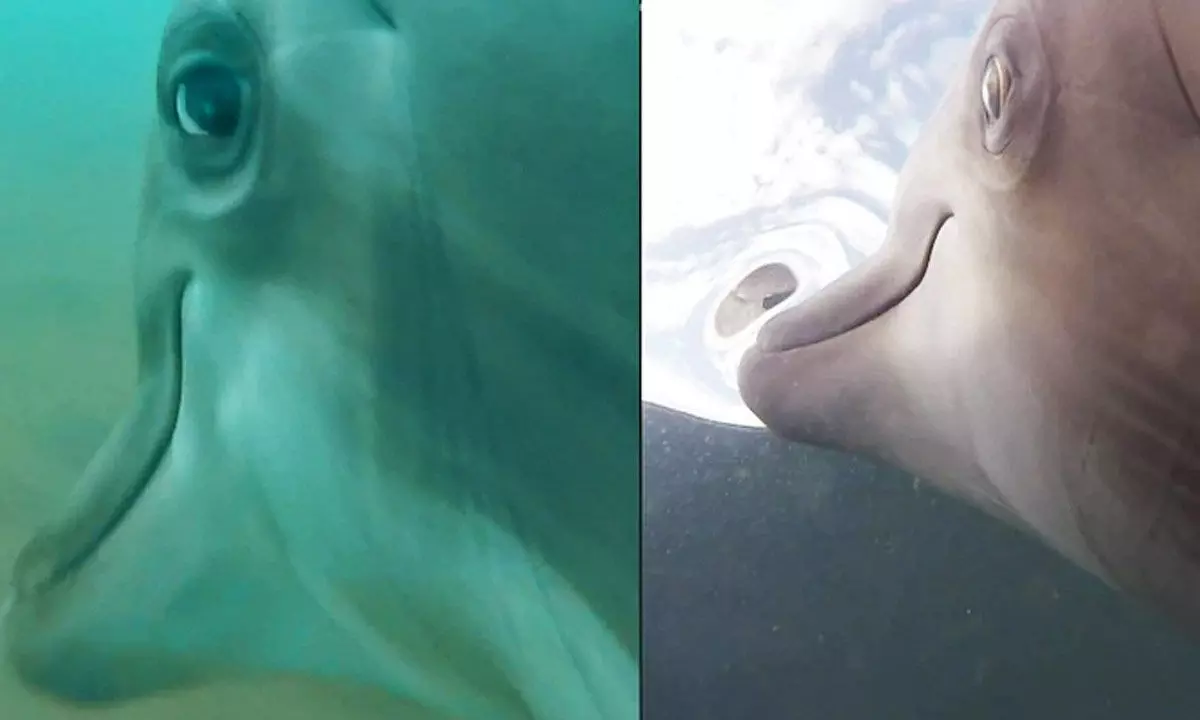Live
- Prime Minister Modi Talks Politics and Peace in New Podcast with Nikhil Kamat
- Google Plans to Launch Innovative AI Products in 2025
- Sneha shares lead with Rhea, Durga in WPGT
- AP High Court Dismisses Quash Petition of Chevireddy Bhaskar Reddy
- Telangana CM Revanth Reddy Announces Visionary 'Future City' Development
- Prannoy, Malvika, Satwik/Chirag, Dhruv/Tanisha reach Round of 16
- Rotary Club launches blanket distribution drive for tribal families
- Game Changer Leaked Online: Watch Legally in Theatres or Trusted Platforms
- ASHA hospitals wait for Rs. 500 cr dues
- Coach Gambhir’s stint riddled with setbacks, says Kaif
Just In
US Navy Put Cameras On Dolphins And Found Exciting Chases


US Navy Put Cameras On Dolphins And Found Exciting Chases
- First-ever footage from the perspective of dolphins freely hunting off the coast of North America is composed of a buzz of clicks and triumphant squeals.
- To the amazement of the researchers, the cunning marine animals delivered thrilling chases and even targeted poisonous sea snakes.
First-ever footage from the perspective of dolphins freely hunting off the coast of North America is composed of a buzz of clicks and triumphant squeals.The US Navy granted their dolphins full reign to hunt in San Diego Bay after strapping cameras to them and training them to assist detect underwater explosives and safeguard some of the country's nuclear arsenal.
To the amazement of the researchers, the cunning marine animals delivered thrilling chases and even targeted poisonous sea snakes.They still don't fully understand many fundamental aspects of these very gregarious and frequently disgusting cetaceans, including their regular feeding habits, despite the fact that they are well-known and widely popular animals.
The general consensus among researchers is that there are at least two methods: sucking up prey like noodles from a bowl and chowing them down like a state fair hot dog in between rides. But a lot more has been revealed by the video.
Six bottlenose dolphins were equipped with cameras from the US National Marine Mammal Foundation which captured footage and audio over the course of six months. These recordings have given us new insights into the hunting techniques and social interactions of these mammals.
Their mouths and eyes were shown in disturbingly off-angle positions when the recording equipment was positioned on their sides or backs.
Although these dolphins are not in the wild, they are regularly given the chance to hunt in the open ocean as a supplement to their typical diet of frozen fish. Therefore, as the NMMF marine mammal veterinarian Sam Ridgway and colleagues explain, it is likely that these species behave similarly to their wild cousins.
More than 200 fish, including bass, croakers, halibut, smelt, and pipefish, were caught by the dolphins with cameras fastened to them. The smelt frequently threw themselves into the air in an effort to flee the cunning hunters. However, the dolphins kept track of their every move and used a method they had previously seen in wild dolphins, swimming upside down to allow their swivelling eyes a clear view.
These dolphins appeared to search for prey using both sight and sound. The dolphins always used echolocation to locate fish from a distance. Close up, it looked that echolocation and eyesight were employed in tandem.
The cameras also captured the sound of the animals' racing hearts as they struggled to keep up with the demanding activities. This footage showed that instead of ramming their prey to the ground, the dolphins used suction to gulp down their still-fighting prey with their remarkably powerful throat muscles.
The cameras also captured the sound of the animals' racing hearts as they struggled to keep up with the demanding activities. This footage showed that instead of ramming their prey to the ground, the dolphins used suction to gulp down their still-fighting prey with their remarkably powerful throat muscles.
The dolphins' throat muscles sprang into action, and their tongues retracted out of the way as they largely swallowed fish into the sides of their open mouths. Their muscles for sucking add to the negative pressure that is produced by the increased inner mouth space.
While dolphins have been observed playing with snakes in the past, including river dolphins amusing a ridiculously huge anaconda, the video provided definitive evidence that dolphins may also consume these animals.

© 2025 Hyderabad Media House Limited/The Hans India. All rights reserved. Powered by hocalwire.com






